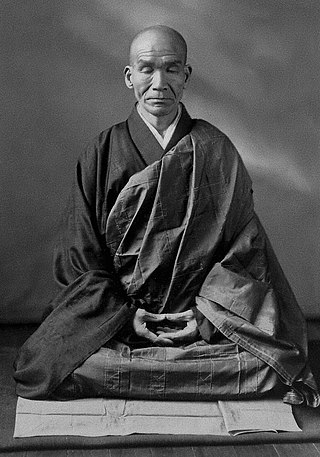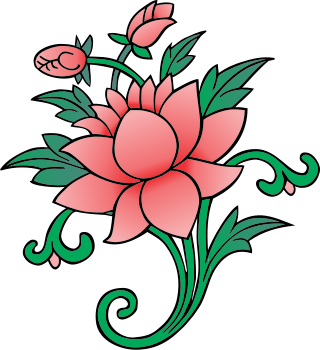
Dōgen Zenji, was a Japanese Zen Buddhist monk, writer, poet, philosopher, and founder of the Sōtō school of Zen in Japan. He is also known as Dōgen Kigen (道元希玄), Eihei Dōgen (永平道元), Kōso Jōyō Daishi (高祖承陽大師), and Busshō Dentō Kokushi (仏性伝東国師).

Zazen is a meditative discipline that is typically the primary practice of the Zen Buddhist tradition.

Sōtō Zen or the Sōtō school is the largest of the three traditional sects of Zen in Japanese Buddhism. It is the Japanese line of the Chinese Cáodòng school, which was founded during the Tang dynasty by Dòngshān Liánjiè. It emphasizes Shikantaza, meditation with no objects, anchors, or content. The meditator strives to be aware of the stream of thoughts, allowing them to arise and pass away without interference.

Yantou Quanhuo (828–887) was an ancient Ch'an master of Yantou Monastery in Ezhou, China. A dharma heir of Deshan Xuanjin, Quanho was born in Quanzhou and became a novice monk at Baoshu Temple in Changan, China. Known to be an avid traveler, Yantou eventually began studying Ch'an under Deshan and received Dharma transmission from him. He then became master of Yantou Monastery, where he led a congregation of students. In 887 on the "eighth day of the fourth month" his temple was raided by bandits. When the bandits realized the temple had nothing of value to take, one of them stabbed Yantou—murdering him. It is said that his scream at death could be heard for ten miles. He was given the title Ch'an Master Clear Severity following his death. Yantou is the subject of several koan cases that appear in the Mumonkan such as case number 13, titled "Tokusan Carries His Bowls".

Shōhaku Okumura is a Japanese Sōtō Zen priest and the founder and abbot of the Sanshin Zen Community located in Bloomington, Indiana, where he and his family currently live. From 1997 until 2010, Okumura also served as director of the Sōtō Zen Buddhism International Center in San Francisco, California, which is an administrative office of the Sōtō school of Japan.

Kosho Uchiyama was a Sōtō Zen monk, origami master, and abbot of Antai-ji near Kyoto, Japan.
Gentō Sokuchū was a Sōtō Zen priest and the 50th abbot of Eihei-ji, the school's head temple. He was part of a 17th and 18th century movement within the Sōtō school that sought to bring the school's teachings back in line with those of the 13th century founding teacher, Dōgen. To this end, he edited major editions of works by Dōgen and succeeded in disseminating them widely. He is best remembered for compiling the Eihei Rules of Purity, a collection of writings by Dōgen laying out a strict code of conduct for monks. These rules had been largely unheeded in the school in the preceding several centuries, and Gentō used his high position as abbot of Eihei-ji to reintroduce and enforce them. His work on the Eihei Rules of Purity was completed in 1794 while he was serving as the eleventh abbot of Entsū-ji. The following year he became the 50th abbot of Eihei-ji. He was also involved in editing Dōgen's master work, the Shōbōgenzō.

Hongzhi Zhengjue, also sometimes called Tiantong Zhengjue (1091–1157), was an influential Chinese Chan Buddhist monk who authored or compiled several influential texts. Hongzhi's conception of silent illumination is of particular importance to the Chinese Caodong Chan and Japanese Sōtō Zen schools. Hongzhi was also the author of the Book of Equanimity, an important collection of kōans.

An ango (安居), or kessei (結制), is a Japanese term for a three-month period of intense training for students of Zen Buddhism, lasting anywhere from 90 to 100 days. The practice during ango consists of meditation (zazen), study, and work.

Jisho Warner is a Sōtō Zen priest and abiding teacher of Stone Creek Zen Center in Sonoma County, California. Warner is a former president of the Soto Zen Buddhist Association, and its first female and first LGBTQ president. Having graduated from Harvard University in 1965, she became an artist and freelance editor. She has edited books by Robert Thurman, Ed Brown, Wendy Johnson, Jane Hirshfield, Dainin Katagiri, and many others. She is a co-editor of the book Opening the Hand of Thought by Kosho Uchiyama, whose teachings she first encountered in the 1980s while practicing at the Pioneer Valley Zendo in Massachusetts under Koshi Ichida.
Daigo-tettei is a Japanese term used within Zen Buddhism, which usually denotes a "great realization or enlightenment." Moreover, "traditionally, daigo is final, absolute enlightenment, contrasted to experiences of glimpsing enlightenment, shōgo" or kenshō. According to Dōgen in a fascicle of the Shōbōgenzō titled Daigo, the master Dōgen writes that when practitioners of Zen attain daigo they have risen above the discrimination between delusion and enlightenment. Author J.P. Williams writes, "In contrast, in SG Daigo, the apparently positive 'great enlightenment' is more clearly an extension of the meaning of fugo, no-enlightenment, than 'enlightenment.'
Bendōwa (辨道話), meaning Discourse on the Practice of the Way or Dialogue on the Way of Commitment, sometimes also translated as Negotiating the Way, On the Endeavor of the Way, or A Talk about Pursuing the Truth, is an influential essay written by Dōgen, the founder of Zen Buddhism's Sōtō school in Japan.

Tenshin Zenki Reb Anderson is an American Buddhist who is a Zen teacher in the Sōtō Zen tradition of Shunryu Suzuki. He is a senior dharma teacher at the San Francisco Zen Center and at Green Gulch Farm Zen Center in Marin County, California, where he lives. According to author James Ishmael Ford, "Reb Anderson is one of the most prominent of contemporary Western Zen teachers."
William Marvin Bodiford is an American professor and author. He teaches Buddhist Studies and religion in the cultures of Japan and East Asia at the University of California, Los Angeles.
Tenzo Kyōkun (典座教訓), usually rendered in English as Instructions for the Cook, is an important essay written by Dōgen, the founder of Zen Buddhism's Sōtō school in Japan.
Genjōkōan (現成公按), translated by Tanahashi as Actualizing the Fundamental Point, is an influential essay written by Dōgen, the founder of Zen Buddhism's Sōtō school in Japan. It is considered one of the most popular essays in Shōbōgenzō.
Sokushin zebutsu, rendered in English as Mind is Itself Buddha, is a book of the Shōbōgenzō by the 13th century Sōtō Zen monk Eihei Dōgen. It was written in the spring of 1239 at Dōgen's monastery Kōshōhōrin-ji in Kyoto. The book appears as the fifth book in both the 75 and 60 fascicle versions of the Shōbōgenzō, and it is ordered sixth in the later chronological 95 fascicle Honzan editions. The title Sokushin zebutsu is an utterance attributed to the 8th century Song Dynasty Zen monk Mazu Daoyi in a well known kōan that appears most notably as Case 30 in The Gateless Barrier, although Dōgen would have known it from the earlier Transmission of the Lamp. In addition to this book of the Shōbōgenzō, Dōgen also discusses the phrase Sokushin zebutsu in several of his formal Dharma Hall Discourses, namely numbers 8, 75, 319, and 370, all of which are recorded in the Eihei Kōroku.
Gyōbutsu igi, known in English as Dignified Behavior of the Practice Buddha, is a book of the Shōbōgenzō by the 13th century Sōtō Zen monk Eihei Dōgen. It was written in the winter of 1241 at Dōgen's monastery Kōshōhōrin-ji in Kyoto. The book appears as the sixth book in both the 75 and 60 fascicle versions of the Shōbōgenzō, and it is ordered 23rd in the later chronological 95 fascicle Honzan editions. Dōgen discusses similar concepts in two of his formal Dharma Hall Discourses, namely number 119, which was written shortly after Gyōbutsu igi, and number 228, both of which are recorded in the Eihei Kōroku. The title is a quotation from the final chapter of Buddhabhadra's translation of the Avataṃsaka Sūtra where the phrase was used to simply describe the Buddha, "bearing himself as a Buddha." Dōgen substantially reimagines the meaning of the phrase in this fascicle.
Eihei Kōroku, also known by its English translation Dōgen's Extensive Record, is a ten volume collection of works by the Sōtō Zen monk Eihei Dōgen. The bulk of the text, accounting for volumes one through seven, are "Dharma hall discourses", which are highly formalized Dharma talks, given from 1236 to 1252. Volume eight consists of "informal meetings" that would have taken place in Dōgen's quarters with select groups of monks, as well as "Dharma words", which were letters containing practice instructions to specific students. Volume nine includes a collection of 90 traditional kōans with verse commentary by Dōgen, while volume 10 collects his Chinese poetry.
Ikka myōju, known in English as One Bright Jewel or One Bright Pearl, is a book of the Shōbōgenzō by the 13th century Sōtō Zen monk Eihei Dōgen. It was written in the summer of 1238 at Dōgen's monastery Kōshōhōrin-ji in Kyoto. The essay marked the beginning of a period of high output of Shōbōgenzō books that lasted until 1246. The book appears as the seventh book in both the 75 and 60 fascicle versions of the Shōbōgenzō, and it is ordered fourth in the later chronological 95 fascicle Honzan editions. The essay is an extended commentary on the famous saying of the Tang dynasty monk Xuansha Shibei that "the ten-direction world is one bright jewel", which in turn references the Mani Jewel metaphors of earlier Buddhist scriptures. Dōgen also discusses the "one bright jewel" and related concepts from the Shōbōgenzō essay in two of his formal Dharma Hall Discourses, namely numbers 107 and 445, as well as his Kōan commentaries 23 and 41, all of which are recorded in the Eihei Kōroku.











